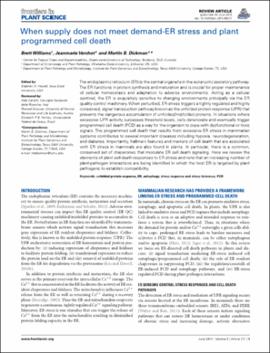| dc.contributor.author | Williams, Brett | |
| dc.contributor.author | Verchot, Jeanmarie | |
| dc.contributor.author | Dickman, Martin B. | |
| dc.date.accessioned | 2019-09-25T18:24:43Z | |
| dc.date.available | 2019-09-25T18:24:43Z | |
| dc.date.issued | 2014-06-04 | |
| dc.identifier | oksd_williams_whensupplydoesn_2014 | |
| dc.identifier.citation | Williams, B., Verchot, J., & Dickman, M. B. (2014). When supply does not meet demand-ER stress and plant programmed cell death. Frontiers in Plant Science, 5. https://doi.org/10.3389/fpls.2014.00211 | |
| dc.identifier.uri | https://hdl.handle.net/11244/321441 | |
| dc.description.abstract | The endoplasmic reticulum (ER) is the central organelle in the eukaryotic secretory pathway. The ER functions in protein synthesis and maturation and is crucial for proper maintenance of cellular homeostasis and adaptation to adverse environments. Acting as a cellular sentinel, the ER is exquisitely sensitive to changing environments principally via the ER quality control machinery. When perturbed, ER-stress triggers a tightly regulated and highly conserved, signal transduction pathway known as the unfolded protein response (UPR) that prevents the dangerous accumulation of unfolded/misfolded proteins. In situations where excessive UPR activity surpasses threshold levels, cells deteriorate and eventually trigger programmed cell death (PCD) as a way for the organism to cope with dysfunctional or toxic signals. The programmed cell death that results from excessive ER stress in mammalian systems contributes to several important diseases including hypoxia, neurodegeneration, and diabetes. Importantly, hallmark features and markers of cell death that are associated with ER stress in mammals are also found in plants. In particular, there is a common, conserved set of chaperones that modulate ER cell death signaling. Here we review the elements of plant cell death responses to ER stress and note that an increasing number of plant-pathogen interactions are being identified in which the host ER is targeted by plant pathogens to establish compatibility. | |
| dc.format | application/pdf | |
| dc.language | en_US | |
| dc.publisher | Frontiers Media | |
| dc.rights | This material has been previously published. In the Oklahoma State University Library's institutional repository this version is made available through the open access principles and the terms of agreement/consent between the author(s) and the publisher. The permission policy on the use, reproduction or distribution of the material falls under fair use for educational, scholarship, and research purposes. Contact Digital Resources and Discovery Services at lib-dls@okstate.edu or 405-744-9161 for further information. | |
| dc.title | When supply does not meet demand-ER stress and plant programmed cell death | |
| osu.filename | oksd_williams_whensupplydoesn_2014.pdf | |
| dc.description.peerreview | Peer reviewed | |
| dc.identifier.doi | 10.3389/fpls.2014.00211 | |
| dc.description.department | Entomology and Plant Pathology | |
| dc.type.genre | Article | |
| dc.type.material | Text | |
| dc.subject.keywords | pcd | |
| dc.subject.keywords | stress response and stress tolerance | |
| dc.subject.keywords | unfolded protein response | |
| dc.subject.keywords | er | |
| dc.subject.keywords | autophagy | |
